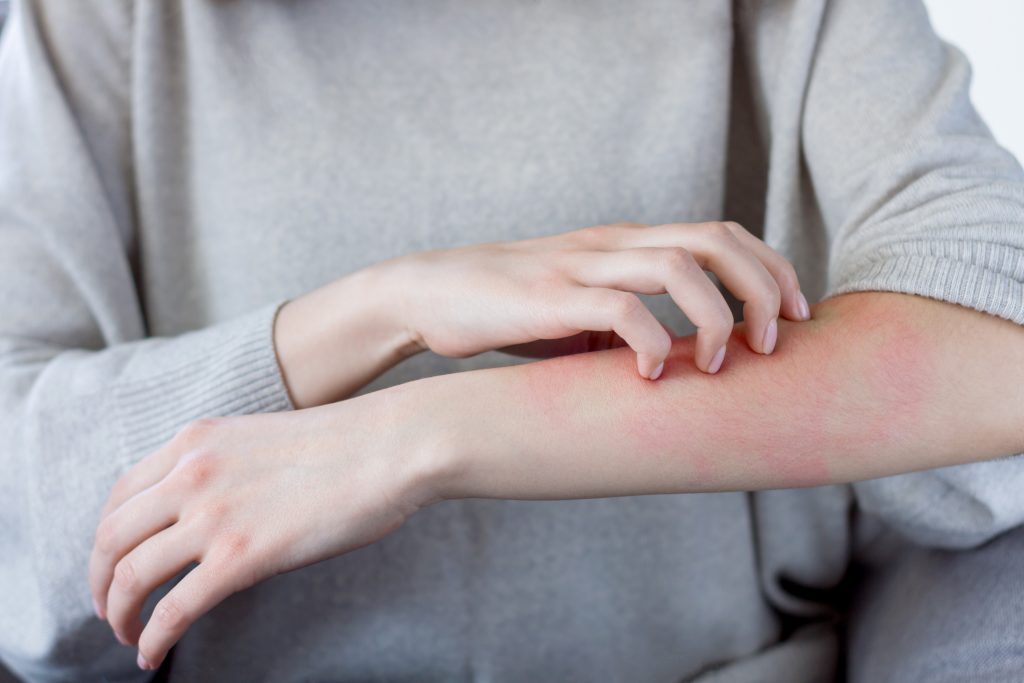What Does Dermatitis Look Like?

Dermatitis is the medical term for common skin irritation. Because so many skin conditions share symptoms and look alike, knowing what dermatitis looks like both broadly and specifically will help you take care of your skin more effectively. Dermatology Associates at Plymouth Meeting research, diagnose and treat all types of dermatitis to ensure our patients receive the best care possible.
Typical Dermatitis Signs and Symptoms
There are many types of dermatitis – they’re separated based on their main trigger/cause and location on the body. Despite these differences, most forms of skin irritation present themselves in the same ways. Typical signs include rash on swollen skin that varies in color (depending on skin color), blisters (sometimes with oozing and crusting) and flaking, thickened skin (dandruff).
If your skin is experiencing one or more of these symptoms, dermatitis might be to blame. But to properly treat your problem, it’s important to identify the potential causes of this irritation and consider the implications of its location(s). Doing so will help you determine the specific type of dermatitis you may be dealing with.
Different Types of Dermatitis and What They Look Like
Let’s discuss some of the most common types of dermatitis and how they typically look on the skin.
Atopic Dermatitis (Eczema)
Eczema is a chronic skin condition common in children (though people of any age can suffer from it) that can occur anywhere on the body. Common symptoms include dry, raw skin, itchiness, rash, discoloration, thickening of the skin, oozing, crusting and more.
Contact Dermatitis
Contact dermatitis occurs when the skin directly contacts an irritant, such as a substance or material that triggers an allergic response. Symptoms can vary, including itchy rashes, hyperpigmented patches, scale skin, bumps, blisters, swelling and more. These symptoms appear wherever the skin comes into contact with the triggering material.
Cradle Cap
As its name suggests, cradle cap is found exclusively among infants, presenting itself in the form of yellowish, flaky patches on the scalp sometimes accompanied by slight redness. These patches don’t cause pain but can be difficult to remove (they usually clear up on their own over weeks or months).
Diaper Rash
Another form of dermatitis that affects children, diaper rash is a common issue that occurs on a baby’s bottom, typically due to chafing and excess moisture in the diaper region. Common signs of diaper rash include skin inflammation, tender skin, sores, and general discomfort in the diaper area.
Seborrheic Dermatitis (Dandruff)
Mostly associated with an itchy, flaky scalp, dandruff (seborrheic dermatitis) can also lead to scaly patches and inflammation on the face, sides of the nose, ear creases, eyelids, chest and other oily parts of the body. Rashes and patches from this form of dermatitis are often ring-shaped/circular. This condition is the adult version of cradle cap.
Can Other Skin Problems Be Mistaken for Dermatitis?
As mentioned earlier, dermatitis isn’t the only skin problem that results in reddened, inflamed, itchy, irritated skin. If not properly diagnosed, dermatitis may be mistaken for the following conditions:
- Cutaneous lupus
- Psoriasis
- Skin lymphoma
- Skin infections
- Polymorphous light eruption
- Allergic contact dermatitis
- And more.
Likewise, symptoms from the skin conditions above may be mistaken for dermatitis. As such, it’s crucial to see a trusted and qualified dermatologist to properly assess your skin and receive the best care. At Dermatology Associates at Plymouth Meeting, our board-certified professionals know the ins and outs of every skin condition and can help deliver the proper diagnosis and treatment for your issue(s).
How Do I Know If I Have Dermatitis?
If you notice any of the dermatitis signs and symptoms mentioned here, contact your dermatological provider – they will ask about the symptoms you’re experiencing and take a close look at your skin, specifically for classic signs of dermatitis such as a rash, redness, scales and dryness.
What Happens if Dermatitis Is Left Untreated?
On its own, dermatitis isn’t life-threatening or contagious – it can, however, increase your risk of bacterial skin infection from regular scratching at your irritated skin. The longer you wait to treat your dermatitis, the more exposed to this threat your skin becomes, so it’s important to find the right treatment plan for your skin early on.
Identify and Deal with Your Dermatitis
Dermatitis can be frustrating and often uncomfortable. Fortunately, dermatitis is increasingly manageable, in no small part thanks to the clinical research being done at Dermatology Associates at Plymouth Meeting. Our team is currently studying atopic dermatitis and will soon launch clinical trials for pruritus (itching) in patients with atopic dermatitis.
If you’re struggling with dermatitis or other skin problems, we’re here to help. Book an appointment today. And if you would like to participate in our ongoing research, contact us at 610.947.4322 to see how we can help.
